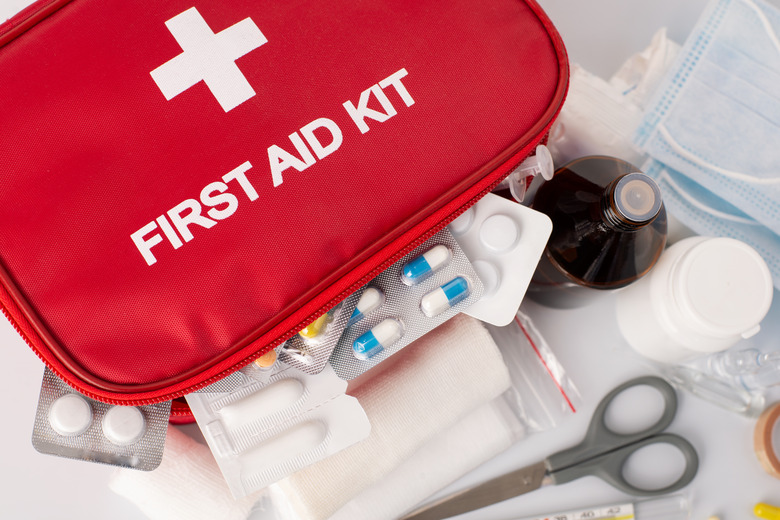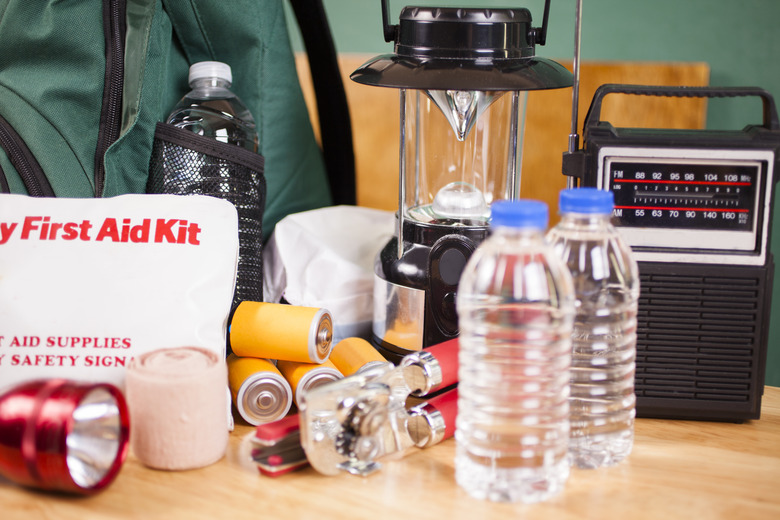Emergency Evacuation Checklist
We may receive a commission on purchases made from links.
If the entire history of the planet could be compressed into a single year, all of written human history would occur in the final second of that year. For most of the "year," the earth has been in upheaval, but the final "second" has seen a period of relative calm and stability. Still, every so often, humans get a harsh reminder of just how fragile that stability is and what the next second could bring.
Earthquakes, tsunami waves, volcanos, severe weather phenomena and wildfires are but a few of the disasters that can disrupt the tranquility of everyday life and force entire communities of traumatized people to abandon their homes. With luck, the displacement is only temporary, but sometimes it is not. No community on the planet is entirely safe, so preparing for emergencies is essential.
Tip
Emergency evacuations are easier when you have an emergency plan and put together an emergency kit with necessary food and supplies.
How Emergency Evacuations Happen
How Emergency Evacuations Happen
Emergency evacuations don't always happen quickly. If a storm is approaching, or you have warning of some other threat, you may have a day or two to prepare. However, many disasters strike without warning, and when the call comes to evacuate, you may have little time to respond. It can be disorienting, and it's easy to forget things you wish you had brought or had done. Using natural disaster resources and preparing ahead of time can make the sudden evacuation easier.
Preparing When You Have Time
Preparing When You Have Time
If you're in the path of a hurricane or a severe rainstorm, you usually get plenty of warning. Meteorologists can predict the path of large storms several days in advance, and when an evacuation is warranted, the order usually comes two or three days before the event. Here are some of the most important things to do before you leave:
- Take care of your pets. If conditions are too dangerous for you to stay, they are also too dangerous for your pets. If you have small pets, you need a pet carrier to keep them safe. Some communities don't allow pets in evacuation centers occupied by people, so your dogs, cats and pet snakes may have to go to designated shelters, where they will need food and other supplies. Don't forget to pack these supplies. If you have large animals, such as horses, transport them to appropriate shelter locations well before the storm arrives.
- Turn off the electricity, water and gas. If your house sustains damage, you want to be sure the damage isn't be exacerbated by home flooding, electrical arcing or gas fires. Turning off the utilities also protects the other homes in your neighborhood.
- Clean your yard. Store children's toys and lawn furniture inside to prevent high winds from turning them into dangerous projectiles.
- Cover the windows. High winds can shatter glass, and once that happens, everything inside the house is exposed to the elements.
- Secure the house. Shut all the windows and doors, including the garage door. Lock all windows and doors before leaving. Move all the furniture and valuables to the center of the room away from the windows if you have time.
- Service the car and fill it with gas. Plan your evacuation route, keeping in mind that the roads may be blocked with traffic.
- Prepare a survival kit. Disaster authorities recommend making an emergency kit before a disaster strikes so you can grab it at a moment's notice. If you haven't done this, now is the time.
Preparing for a Quick Evacuation
Preparing for a Quick Evacuation
Having a family emergency plan helps you know how to respond. If a wildfire or tornado is approaching, you may get an order to evacuate immediately. Time is of the essence in such a situation, and a delay of five minutes could be a life or death matter.
The first thing to do is to start the car. Close the windows, but be sure to leave the doors unlocked. You won't have time to sort through your personal belongings, so just leave them behind. They will just take up valuable space in your car that you need to evacuate the people and pets who need to leave.
Bring only the bare survival necessities you need for the next three days. Make sure everyone is safely in the car, then drive along the prescribed evacuation route to safety.
What to Take
What to Take
The first thing to pack in the car is your survival kit. Some things to include in the kit are:
- Food. Enough non-perishable food to feed everyone in your party for at least three days. Bring infant food if you have toddlers and pet food if you have pets.
- Water. Bring one gallon of water per person per day for three days. A four-person family, for example, requires 12 gallons of water.
- Important documents. Documents to bring include passports, driver's licenses, proof of insurance and medical records. You may want to store digital copies of these documents on a flash drive that you can easily carry with you.
- First aid kit. Pack a first aid kit that contains bandages, disinfectants and any prescription drugs you need to take.
- A flashlight and extra batteries. You can pack a battery-powered flashlight, or your cell phone can double as a flashlight. It's a good idea to have a portable, battery-powered charger in case of a widespread power outage. A micro-jump starter, available at any car parts store and at many big box stores, is perfect for this. It will keep your cell phone charged, and you can use it to jump-start your car if the battery loses charge. It's a good idea to keep one of these plugged into a 12-volt power socket in your car at all times.
- Personal sanitation needs. These include hand sanitizer or moist towelettes and plastic bags and ties for safe waste disposal.
- Cash or credit cards. Cash is preferable, because cards won't work if the power is out.
If you expect to have to take shelter outside, you'll need camping supplies, including a tent, sleeping bags, eating utensils and all the rest of the camping gear you would normally take on a camping trip. If you don't have time to gather camping supplies, leave without them. There will probably be an emergency evacuation shelter outside the disaster area, and if not, people in surrounding communities are usually willing to provide temporary shelter.
Prepare to Avoid the Panic
Prepare to Avoid the Panic
If you live in a fire zone, a hurricane zone or an area that is susceptible to flooding, it pays to make emergency preparations before an emergency occurs. Preparations include maintaining a survival kit with fresh water, which you should change periodically. Your kit should include non-perishable food, and since this is likely to be canned, don't forget the can opener in your supplies. Make sure the kit is accessible and that everyone in the household knows where it is.
Think of disaster mitigation when performing routine maintenance around the house. Prune tree branches that grow too close the house, stack firewood far from buildings and cut overgrown grass and weeds to ensure quick access for emergency personnel. It's a good idea to keep digital pictures and/or descriptions of all your valuables so you'll have records of them when the time comes to file an insurance claim.

